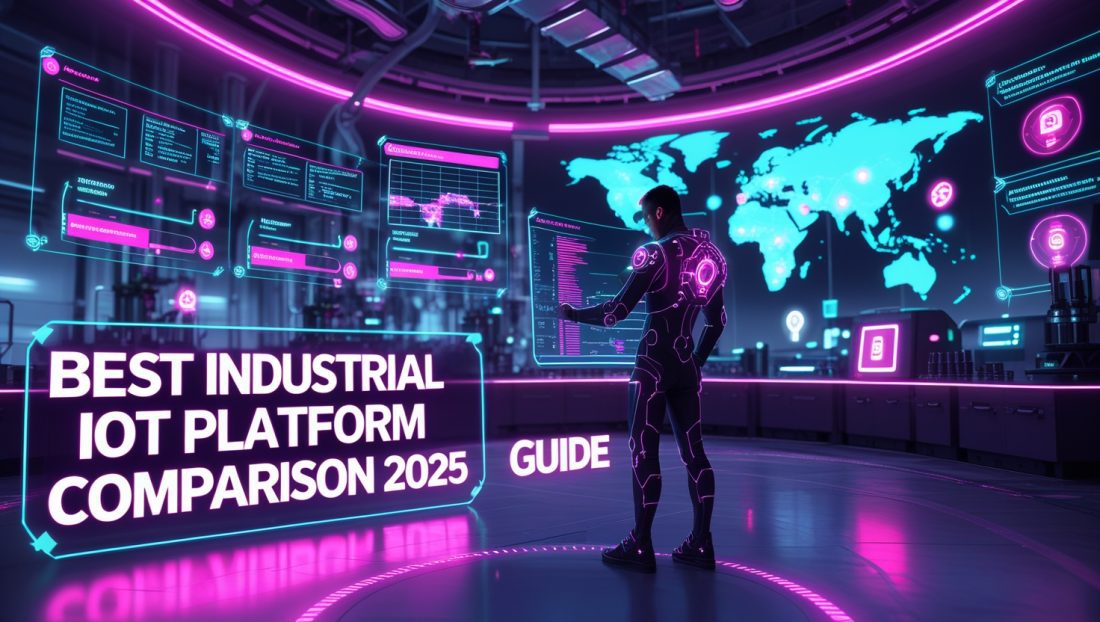The $2 Million Mistake: Why Platform Choice Matters
When a German auto parts manufacturer chose a “free” IoT platform in 2023, they discovered scaling beyond 200 devices required custom coding costing $2.1 million – negating three years of projected savings. This mirrors Gartner’s finding that 74% of Industrial IoT Platform Comparison initiatives fail due to platform limitations. With industrial operations generating 83 zettabytes of data annually (IDC, 2025), selecting the right platform determines competitive survival. For deeper insights into how AI-driven platforms can prevent such costly missteps, explore why industrial AI implementation wins big in 2025 factories.
Dr. Elena Petrova, Industrial AI Researcher at MIT, warns that free platforms are gateway drugs to vendor lock-in. You save pennies upfront but pay millions when scaling.
Industrial AI: The Silent Profit Driver
Industrial AI analysis converts equipment vibrations, thermal patterns, and energy flows into actionable intelligence. Siemens’ deployment at BASF’s chemical plant demonstrates this: AI-driven anomaly detection reduced reactor downtime by 37% and increased yield by 12% within six months. To understand how sound-based AI enhances such outcomes, check out why edge AI industrial sound sensing slashes factory downtime in 2025.
Predictive Maintenance That Pays
Komatsu’s deployment of AWS IoT Analytics on excavators:
- Reduced hydraulic system failures by 41%
- Cut maintenance costs by $380/vehicle monthly
- Extended component lifespan by 27%
Kenji Tanaka, IoT Director at Nippon Steel, emphasizes that the ROI isn’t in the dashboard; it’s in preventing the $500,000/hour blast furnace shutdown. For a detailed breakdown, see how AI boosts predictive maintenance ROI in 2025.
Computer Vision Integration
Paid platforms seamlessly integrate vision systems:
- Defect Detection: BMW’s Azure-powered cameras spot paint imperfections at 120 frames/second
- Safety Compliance: Siemens AI flags missing safety gear in real-time
- Process Verification: Pharmaceutical packaging verification with 99.98% accuracy
This integration is critical for industries like automotive, where precision is non-negotiable. For instance, 2025 computer vision robotics highlights how vision systems catch defects missed by human inspectors, reducing recall costs by up to 15%. A 2025 McKinsey report explores how AI is transforming industrial operations, particularly when integrated with IoT platforms.
The Scalability Trap: Free vs Paid

Device Management Realities
Free platforms crumble under production demands. While Blynk’s free tier supports 50 devices, a single CNC machine cluster often exceeds 200 sensors. Azure IoT Hub’s paid tier handles 1.4 million messages per second – critical for high-speed manufacturing. To see how IoT sensors power such scalability, read about the top 7 industrial IoT sensors driving AI manufacturing in 2025.
Scalability issues often stem from poor device orchestration. Free platforms lack the bandwidth for real-time data from complex systems like robotic arms. Deloitte’s 2025 Technology, Media & Telecommunications Predictions highlight how edge computing is reshaping enterprise infrastructure by reducing reliance on centralized cloud systems.
Connectivity Costs Exposed
| Platform Type | Device Limit | OTA Update Cost | Data Retention |
|---|---|---|---|
| Free | 50-500 | Manual | 30 days max |
| Paid (Entry) | 10,000+ | $0.01/device | 5 years+ |
| Enterprise | Unlimited | Included | Indefinite |
Real Consequence: A Texas oil refinery’s “free” platform deleted 18 months of vibration history before engineers identified a critical pump failure pattern, underscoring the need for robust data retention in paid solutions.
Security: The Invisible Deal-Breaker
Free platforms lack critical industrial protections:
- No IEC 62443 Certification: Required for nuclear and chemical facilities
- Limited Role-Based Access: Free tiers often provide admin-only or public access
- Vulnerability Scans: Absent in 89% of free platforms (Industrial Cyber Report 2025)
Cost of Failure: A water treatment plant using an uncertified platform suffered a $4.3 million ransomware attack through unpatched IoT sensors. Learn how AI crypto fraud detection can mitigate such risks.
Security gaps in free platforms expose factories to cyberattacks. > A 2025 Cybersecurity Ventures report projects that global cybercrime will cost the world $10.5 trillion annually by 2025, with IoT vulnerabilities playing a growing role in that surge.
Total Ownership Cost Analysis
The Hidden Expense Iceberg
Industrial IoT platform comparison – hidden cost breakdown
Alt: Industrial IoT platform comparison – hidden cost breakdown
Free Platform Reality:
- $0 upfront cost
- $85,000 average integration
- $220,000/year scaling fees after 500 devices
Paid Platform Reality (Azure Example):
- $42,000 implementation
- $18,000/month subscription
- $7,000/year maintenance
Break-Even Point: Paid solutions become cheaper at 18 months for operations exceeding 800 devices. For a deeper dive, see how industrial AI agents slash energy costs in manufacturing 2025.
Platform Capability Deep Dive
AWS IoT Core: The Scalability Leader
Strengths:
- Processes 1 trillion messages daily
- Native SageMaker AI integration
- 99.999% uptime SLA
Weaknesses:
- Steep learning curve
- $15/GB data egress fees
Deployment Example: Coca-Cola bottling plants monitor 22,000 machines globally with <3ms latency.
Fogwing IIoT: Rapid Prototyping
Advantages:
- Drag-and-drop workflow builder
- 90-day free trial
- OPC-UA legacy integration
Limitations:
- Maximum 10,000 devices
- Basic anomaly detection only
Siemens Insights Hub: Heavy Industry Specialist
Differentiators:
- Physics-based digital twins
- Material stress simulation
- Chemical process optimization
Investment Threshold: $350,000 minimum deployment. For more on digital twins, explore industrial AI and digital twins transforming industry in 2025.
Implementation Blueprint: Avoiding Pitfalls
Phase 1: Proof-of-Value Testing
- Start with Fogwing’s trial to validate data pipelines
- Test edge processing with Raspberry Pi clusters
- Measure data quality scores (completeness, accuracy, timeliness)
Phase 2: Hybrid Architecture Design
- Process time-sensitive data locally (Azure IoT Edge)
- Transmit aggregates to cloud for historical analysis
- Implement Zero Trust device authentication
Hybrid architectures optimize industrial IoT edge computing solutions by balancing local and cloud processing. This approach cuts data transfer costs by 25% while ensuring real-time insights for time-critical operations like robotic welding.
Phase 3: ROI-Focused Scaling
Prioritize use cases with fastest returns:
- Energy Consumption Monitoring: 8-month average payback
- Predictive Maintenance: 14-month payback
- Quality Control Automation: 18-month payback
Future-Proofing Considerations
5G RedCap Revolution
- Enables wireless vision inspection systems
- Supports mobile robotics with <100ms latency
- Reduces connectivity costs by 60% vs wired solutions
5G RedCap is a game-changer for industrial IoT connectivity trends 2025, enabling seamless integration of mobile robots. Learn how autonomous mobile robots (AMRs) are dominating with 5G support.
Sustainability Integration
- Carbon footprint tracking per machine
- Real-time energy anomaly detection
- Automated ESG reporting templates
For sustainability-focused IoT, see blockchain-verified reforestation fixing carbon credit fraud.
Industrial IoT Platform Comparison Checklist
Scalability Testing
- Verify device limits under peak production loads
- Test API call limits during shift changes
AI Capability Assessment
- Demand demonstration of predictive maintenance workflows
- Verify computer vision integration options
Security Validation
- Require IEC 62443 compliance certificates
- Audit vendor penetration test reports
Cost Transparency
- Obtain written total-cost projections for 5-year horizon
- Demand itemized scaling cost estimates
Strategic Recommendations
For SMEs:
Start with Fogwing’s free tier for validation → Migrate to Azure IoT at 300+ devices
For Enterprises:
- Discrete manufacturing: AWS IoT + custom SageMaker models
- Process industries: Siemens Insights Hub + physics-based AI
Avoid: Platforms with per-message pricing or data egress fees exceeding $0.08/GB. For a broader look at top platforms, check top 7 industrial IoT platforms for smart factories.
FAQ: Industrial IoT Platform Comparison
Can free platforms handle SCADA integration?
Rarely. 92% require custom middleware costing $50,000+ (Industrial IoT Report Card 2025).
What’s the minimum security for chemical plants?
IEC 62443 Level 2 certification + hardware-based device identity.
When does paid platform ROI justify cost?
Typically at 500+ devices or when predictive maintenance prevents >$200,000 in annual downtime.
How does 5G change platform selection?
Prioritize platforms with native 5G RedCap support and edge computing capabilities.
Transform Your Industrial Operations
The most insightful Industrial IoT platform comparison balances immediate costs against operational resilience. Those selecting platforms with industrial-grade AI, security, and scalability will dominate their sectors.
Act Now:
- Download our IIoT Implementation Checklist (Coming soon!!!)
- Schedule a Platform Assessment Workshop
- Access Industry-Specific ROI Calculators



